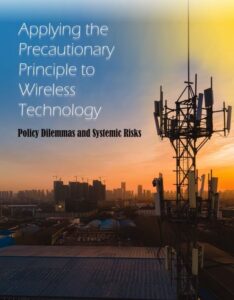Ben Ishai P, Baldwin HZ, Birnbaum LS, Butler T, Chamberlin K, Davis DL, Scarato T, Taylor H (2024). Applying the Precautionary Principle to Wireless Technology: Policy Dilemmas and Systemic Risks. Environment: Science and Policy for Sustainable Development. 66:2, 5-18. DOI: 10.1080/00139157.2024.2293631. Open access paper published online: 20 Feb 2024.
: https://www.tandfonline.com/doi/epub/10.1080/00139157.2024.2293631
Conclusions
Today, we are with RFR from wireless devices where we were with asbestos and tobacco in the 1970s. Sufficient scientific evidence has accumulated to demonstrate the risk of adverse health effects to humans from exposure to RFR at permitted levels of exposure. Children and fetuses are especially at risk, as are insect species in the environment. It is time to act now to reduce exposure, rather than insisting on more proof of human or environmental harm. Indeed, emerging studies of children and wireless devices are providing evidence of serious behavioral and cognitive consequences that may well be tied with both physiological and psychological consequences of exposures.
Based on the evidence to date, we believe that the case for precaution concerning wireless radiation rests on solid scientific foundations. Human health and the health of the physical environment are both at risk from current and planned expansions of exposure. Experimental evidence demonstrates risks to development that can occur from ambient levels of exposure to wireless radiation that affect the functioning of human cells, mitochondria, and DNA via its ability to generate reactive oxygen species (ROS) and place cells into oxidative stress, creating a cascade of related adverse health impacts and disease endpoints. Although exposures are invisible and mostly undetectable, they can have permanent effects on our ability to reproduce and to live a good quality and healthy life. Therefore, we urge that a serious program of research and training must be established and independently funded so that additional research can be developed to clarify the public health and environmental impacts of wireless radiation. In the meantime, actions must be taken to reduce exposures based on the implementation of the precautionary principle. In essence: It is better to be safe than to be sorry. Or as Benjamin Franklin quipped centuries ago, “An ounce of prevention is worth a pound of cure.”
Open access paper: https://www.tandfonline.com/doi/epub/10.1080/00139157.2024.2293631


